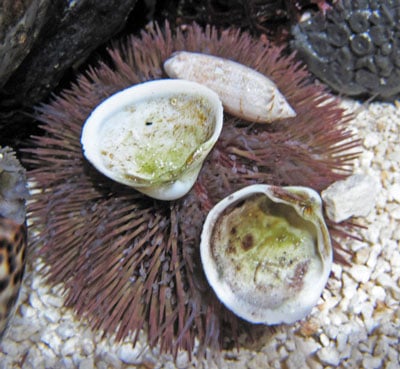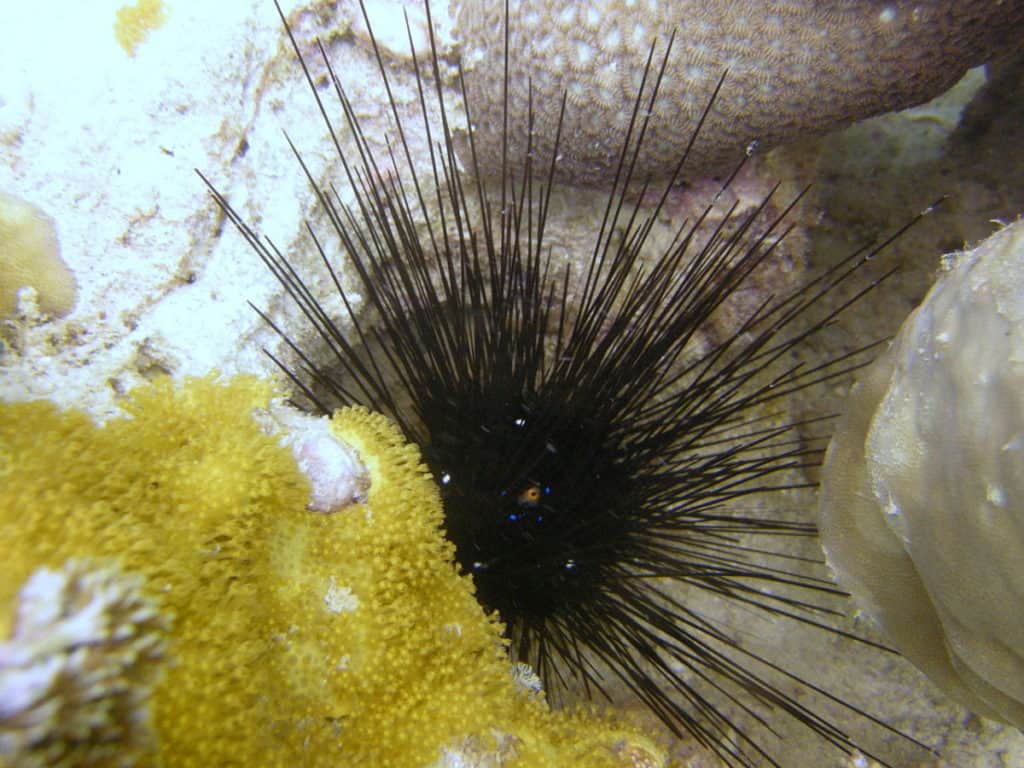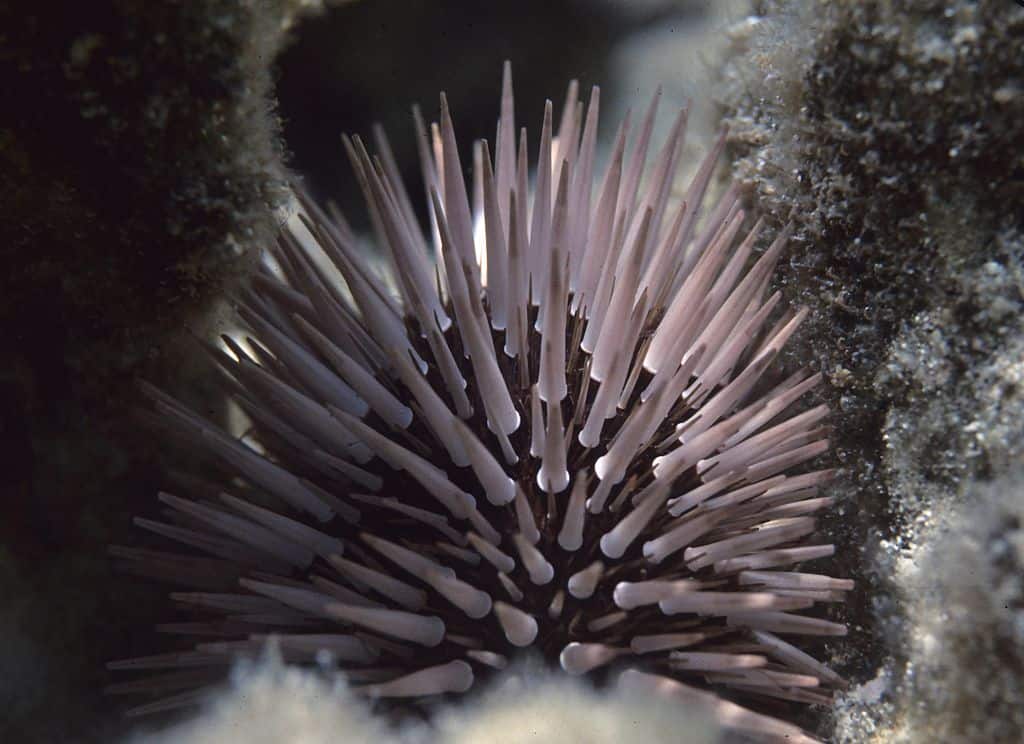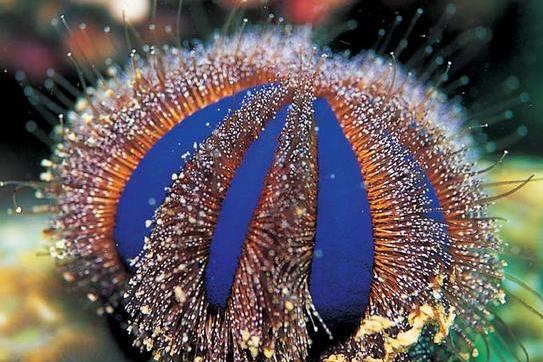Are you looking for something a bit different to add to your aquarium? Have a problem with algae, and are wanting an algae grazer? Then look no further as you have stumbled across the perfect article for you!
Sea urchins are invertebrates, with a soft body and a hard exoskeleton usually covered in spines. Even though these crawling critters can sense light and dark, they will mainly use their sense of smell to navigate around your aquarium, and even though they appear to be slow, they soon get around!
The Best Urchins For a Beginner Saltwater Aquarium Are:
- Pincushion Urchin
- Long-Spined Urchin
- Short-Spine Urchin
- Blue Tuxedo Urchin
Sea urchins will scavenge the aquarium for unwanted algae and detritus that build up in your tank, often carrying things and burying themselves in the substrate. This means they like to overturn rocks, which can damage other aquarium residents (especially corals), the tank, or even themselves, therefore extra care is needed when keeping urchins.
Always be careful when handling them as they can puncture the skin – their spines can break into tiny pieces once inside your skin, making them difficult to remove and painful! Trust Me! The Long-Spined Urchin is the usual culprit!
Urchins are sensitive to water changes and cannot tolerate copper-based medication, so making sure their water parameters are within range is really important!
For success with Urchins, your first priority is to keep your water parameters in the following ranges:
- Temperature: 22.2 – 25.5°C or 72 – 80°F
- Salinity: 30.5 – 33.2 ppt or 1.023 – 1.025sg
- pH: 8.1 – 8.4
- Alkalinity: 8 – 12 dKH
Beginner Tip: Signs of Poor Water Quality is Spine Loss
My Top Beginner Sea Urchins:
As a beginner, it can be overwhelming what urchin(s) to start with. You will want ones that are peaceful, hardy, and easy to care for to ensure you have the greatest success in keeping them. If you have a big enough tank (over 100 gal), you can have more than one – they are solitary animals but do not seem to be aggressive toward each other.
They are scavengers so I would ensure your aquarium has lots of algae for them to feed on. I would recommend you wait at least 6 months after your aquarium cycle has finished before adding your first urchin.
Below are my Top Urchins you can start with that are great for beginners!
Pincushion Urchin
(Lytechinus variegatus)

- Max. Size: 8”
- Diet: Herbivore & Omnivore
- Care Level: Easy
- Temperament: Peaceful
- Min. Tank Size: 20 Gallons
- Priced from: $10.00
These nocturnal urchins, which range in colors from red, white, and blue, are easy to care for, peaceful, and super affordable – which is why they are my favorite for beginners!
Stay away from the Purple Pincushion Urchin as these are not beginner-friendly!
They love hiding, so you will want plenty of hiding spots for them during the day. When they come out at night, they can be seen moving around searching for algae to graze on – particularly live rock. If you do decide to buy a pincushion urchin, make sure that any rock formations are stable, so your urchin does not get stuck between them.
As you can see in the photo, they love to pick up shells, rock rubble, and bits of coral on their spines that they use for camouflage. It can be quite amusing to see how they decorate themselves!
Long-Spined Urchin
(Diadema setosum)

- Max. Size: 10”
- Diet: Herbivore
- Care Level: Easy
- Temperament: Peaceful
- Min. Tank Size: 25 Gallons
- Priced from: $30.00
Also known as the Black Long-Spined Sea Urchin, this one gets its name from the long black spines that are mildly venomous covering its body – no need to worry, they do not threaten us humans, they just sting a little!
They are easily identified by their bright orange anus in the center of its mass of spines. – Officially known as the Periproctal Cone for any science nerds out there like myself!
These guys grow a lot larger than other sea urchins, so ensure you have enough space for them to move around. These guys will take up a lot of room in a nano aquarium so those size tanks are best avoided.
One great thing about these urchins is that they have a symbiotic relationship with Bangai Cardinalfish (Pterapogon kauderni) who will ‘Hang Out’ in the urchins’ spines for protection.
Short-Spined Urchin
(Echinometra sp.)

- Max. Size: 3”
- Diet: Herbivore
- Care Level: Easy
- Temperament: Peaceful
- Min. Tank Size: 20 Gallons
- Priced from: $12.00
Also called the Rock Burrowing Urchin, these round-bodied urchins have hundreds of white/red/orange spines with long tube feet to move around your aquarium.
They get the name ‘Collector Urchin’ as they like to camouflage themselves by covering their body with seaweed and small rocks therefore you will want plenty of live rock for them to graze on and stable rock formations for hiding.
Their diet should also include dried seaweed/nori, especially if your aquarium is still unmatured and relatively algae-free.
Blue Tuxedo Urchin
(Mespilia globulus)

- Max. Size: 3”
- Diet: Herbivore
- Care Level: Easy
- Temperament: Peaceful
- Min. Tank Size: 20 Gallons
- Priced from: $33.00
Also known as the globe urchin – these are very peaceful, easy to care for, and do not grow super big making them suitable for most aquariums. Tuxedo urchins are reef safe and hardy, making them easy to care for, and perfect for beginners.
Tuxedo urchins are covered in hundreds of sort uniform spines that are sharp and can puncture human skin, so handle these guys with care!
As they do not grow too big, they are one of the less ‘clumsy’ ones so will not be knocking over everything in your aquarium – but they are keen scavengers, so will still move small objects around as they search for food.
Tuxedo urchins do not tolerate fluctuations and high levels of nitrate, so it is recommended you supplement your tank and take extra care when acclimatizing them into their new environment.
They are also very sensitive when transporting, so drive carefully with these urchins on board!
Are Urchins Reef Safe?
Urchins are reef-safe and make a great addition to your aquarium. They are good at feeding on nuisance algae and detritus while adding a unique-looking creature to your tank. They can knock corals over as they move so be sure to secure all corals with reef/coral epoxy or similar.
Urchins are slow movers around the tank and do have the nickname of ‘Bulldozer’ because of the fact they just push things out of the way. Urchins like the Long-Spined urchin can take up a lot of real estate with their spines so this is something to consider before purchasing.
To ensure your corals do not get pushed off into the abyss at the back of the rockwork I highly suggest you use a reef-safe coral epoxy like these here:
How Do You Care For Sea Urchins?
To best care for an urchin you need to have an aquarium with sufficient food. An aquarium that is over 6 months old should provide sufficient algae and detritus to ensure the food supply does not run out. Urchins do not do well in new aquariums with little algae and/or coralline growth.
After selecting the correct urchin to match the available space in your aquarium they generally like the same temperature and salinity levels as their tank mates. around 78-80°F with SG around the 1.025 level.
They can be given supplemental food by placing a few pieces of Mysis Shrimp not to them if required, but generally, they will do great so long as the aquarium is mature.
For any urchin ensure your aquarium is at least 20 gallons or larger. Small aquariums make it difficult for an urchin to physically move around which causes them to not be able to find food and eventually, they starve.
Only keep one urchin in an aquarium under 100 gallons. Too many urchins in a small aquarium can exhaust their food supply leading to starvation. On bigger aquariums, more than one urchin is recommended to help with janitorial cleanup.
Who Can Sea Urchins Share A Tank With?
Urchins should not be sharing a tank with aggressive predators such as pufferfish, triggerfish, and octopus. These animals naturally prey on urchins in the wild and will soon decimate any urchin you place in the tank. Urchins are generally compatible in most reef aquariums.
Basically look at the fish in your aquarium, if they look like they have a hard beak-like mouth, then they usually prey on urchins in the wild.
You should also avoid small predatory fish that will swim between the urchin’s spines injuring themselves. As long as you have enough space and food for them, you can have more than one sea urchin as they are generally very peaceful creatures.
What Do You Feed Sea Urchins?
Generally, urchins do not need any feeding. Providing the aquarium is over 6 months old and has a sufficient covering of Coralline and algae then they will have enough food. Urchins are grazers and will move around the tank feeding on Coralline, algae, and detritus.
Most of these spiny critters enjoy munching on algae, but some prefer something a bit ‘meaty’ from time to time. If you are specifically looking for an algae cleaner, then the Tuxedo Urchins are a great choice!
Make sure you do not overfeed your urchins as a build-up of uneaten foods leads to harmful toxins in the water like ammonia – this will not only affect your urchins but their tank buddies too!
Urchins To Avoid & Why!
Some urchins are not compatible with reef fish or corals so, these are urchins you should avoid:
Slate Pencil Urchin
(Heterocentrotus mamillatus)
- Not easy to care for
- Not reef compatible for corals
Purple Short Spine Pincushion Urchin
(Pseudoboletia sp.)
- Semi-aggressive
- Must be added with caution with other reef fish
Long Spine Banded Urchin
(Echinothrix calamaris)
- Not easy to care for
- Venomous
To Finish
By now you should have a basic understanding of what sea urchins are, what ones are beginner-friendly, ones you should avoid, and how to care for them in your saltwater aquarium.
Remember:
- Perform regular water changes.
- Try not to disturb them & damage their spines when cleaning around them.
- Some species are not compatible with all reef fish – do your research before buying!
- They should be kept where there are lots of algae to graze on, otherwise, they will starve – but do not overfeed them.
Further Reading
If you found this article helpful, I highly recommend you check out these ones too:



